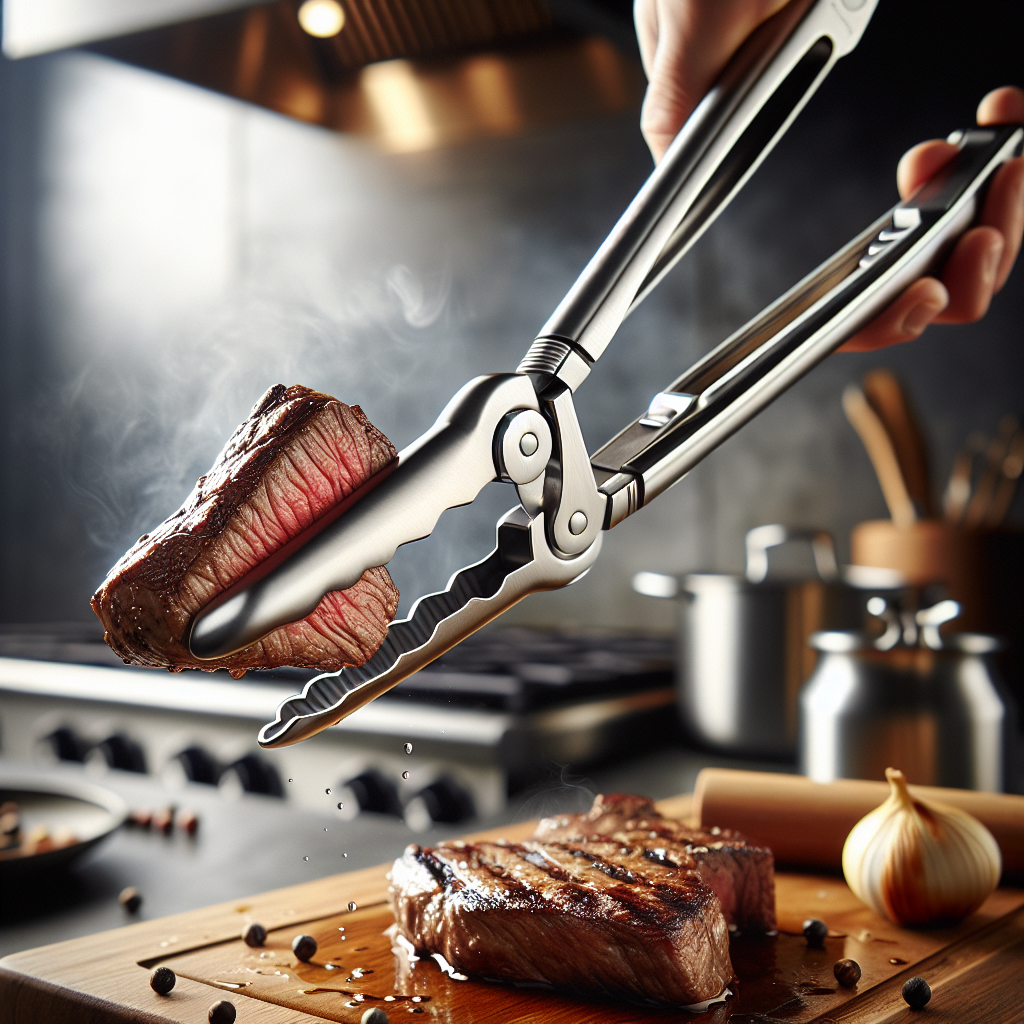In the world of cooking, having the right tools can make all the difference. Among the essential utensils found in every kitchen, kitchen tongs are often overlooked but invaluable. They come in various types, each designed for specific uses, and mastering their science can elevate your cooking experience to a whole new level. In this article, we will explore the different types of kitchen tongs and how they can be utilized to enhance your culinary endeavors. So whether you’re flipping delicate fish fillets or serving a hearty salad, get ready to discover the fascinating science behind these versatile kitchen helpers.

Overview of Kitchen Tongs
Introduction to kitchen tongs
Kitchen tongs are an essential tool in any kitchen, designed to make your cooking experience easier and more efficient. These versatile utensils have a basic design consisting of two arms connected by a pivot point, allowing for easy gripping and manipulation of food. Whether you’re flipping meats on a grill, tossing a salad, or serving up a delicious pasta dish, kitchen tongs are a must-have tool.
Importance of kitchen tongs in cooking
Kitchen tongs play a crucial role in various cooking tasks and are valued for their ability to provide a firm and precise grip on food. They allow you to safely handle hot items, flip delicate foods, mix ingredients, and even extract ice from buckets. With their versatility and practicality, kitchen tongs have become a staple in both professional and home kitchens.
How tongs work
The design of kitchen tongs is based on the principles of leverage and the human grip. The two arms of the tongs work as pincers, allowing you to hold and manipulate food without direct contact with your hands. The pivot point or hinge in the middle of the tongs enables smooth movement and control. By squeezing the handles together, the arms close, firmly grasping the food item. Releasing the pressure on the handles opens the tongs, releasing the food.
Materials used in making tongs
Kitchen tongs are typically made from a variety of materials, each with its own unique set of advantages and properties. Common materials used in the construction of tongs include:
- Silicone: Silicone tongs are heat-resistant, non-stick, and flexible, making them great for use with non-stick cookware and high-temperature cooking.
- Stainless steel: Stainless steel tongs are durable, easy to clean, and resistant to rust and corrosion. They are often used for heavy-duty grilling and barbecue tasks.
- Nylon: Nylon tongs are lightweight, gentle on non-stick surfaces, and heat-resistant up to a certain temperature. They are perfect for use with delicate items or on non-stick pans.
- Bamboo: Bamboo tongs are eco-friendly, lightweight, and ideal for serving and handling food. However, they may not be suitable for high-heat cooking tasks.
- Salad Tongs: Made from various materials such as wood, stainless steel, or plastic, salad tongs are specifically designed for tossing and serving salads.
Types of Kitchen Tongs
Silicone Tongs
Silicone tongs are highly popular due to their heat-resistant properties. They can withstand high temperatures without melting or transferring heat to your hands. Silicone tongs are great for use on non-stick surfaces, as they won’t scratch or damage the coating. They are also easy to clean and dishwasher safe.
Stainless Steel Tongs
Stainless steel tongs are the workhorses of the kitchen. They are incredibly durable, resistant to rust and corrosion, and able to handle heavy items. Stainless steel tongs are commonly used for grilling, barbecue, and other high-heat cooking methods. They can be easily cleaned and are dishwasher safe.
Nylon Tongs
Nylon tongs are lightweight, gentle on delicate foods, and won’t scratch non-stick surfaces. They have a heat resistance up to a certain temperature, making them suitable for a wide range of cooking tasks. Nylon tongs are dishwasher safe and easy to clean.
Bamboo Tongs
Bamboo tongs are an eco-friendly option that is perfect for serving and handling food. They are lightweight, heat resistant, and naturally antimicrobial. However, bamboo tongs may not be suitable for high-heat cooking due to their lower heat resistance.
Salad Tongs
Salad tongs are specifically designed for tossing and serving salads. They come in various materials such as wood, stainless steel, or plastic. Salad tongs allow for easy mixing and serving of ingredients while maintaining the integrity of delicate leafy greens.
Grilling Tongs
Grilling tongs are specifically designed for use on the grill. They are usually made of stainless steel for durability and heat resistance. Grilling tongs have long handles to keep your hands away from the heat, and often have scalloped or serrated edges for a better grip on meats and vegetables.
Pasta Tongs
Pasta tongs are designed to handle and turn pasta during cooking. They often have a long handle and wide, gently curved arms to prevent breakage of delicate pasta strands. Pasta tongs are typically made of stainless steel for durability and ease of cleaning.
Barbecue Tongs
Barbecue tongs are heavy-duty tongs designed for handling large cuts of meat and flipping them on the grill. They are made of sturdy materials like stainless steel and often have long handles for comfort and safety. Barbecue tongs can withstand high temperatures and are easy to clean.
Sugar Tongs
Sugar tongs are small, delicate tongs used for picking up sugar cubes, ice cubes, or other small food items. They are typically made of stainless steel and have small, narrow arms for precise gripping.
Ice Tongs
Ice tongs are designed specifically for extracting ice cubes from buckets or trays. They usually have sharp, pointed ends that easily grip and lift ice. Ice tongs are commonly made of stainless steel and are dishwasher safe for easy cleaning.

Functions and Uses
Grasping and flipping food
Kitchen tongs excel at grasping and flipping food items, such as meats, vegetables, and fish, both on the stovetop and the grill. The firm grip and long reach of tongs allow for precise control, preventing the risk of dropping or damaging the food.
Tossing and mixing ingredients
Whether you’re tossing a fresh salad or mixing ingredients for a marinade, kitchen tongs are the ideal tool. Their arms provide a secure grip on the ingredients, ensuring thorough mixing and even distribution of flavors.
Serving and plating dishes
Kitchen tongs are also great for serving and plating dishes. They allow you to handle and transfer food with precision, ensuring that each plate looks appetizing and professionally presented.
Handling hot items
One of the main benefits of kitchen tongs is their ability to safely handle hot items. Whether you’re flipping a sizzling steak or serving hot pasta, tongs provide a safe and convenient way to manipulate and transfer food without coming into direct contact with high heat.
Cooking on grills and barbecue
Kitchen tongs are a must-have tool for grilling and barbecue enthusiasts. Their long handles and heat resistance make them perfect for safely handling hot meats and vegetables on the grill. You can easily flip, turn, and move items to ensure even cooking without burning yourself.
Extracting ice from buckets
When you need to chill your drinks and cocktails, ice tongs come in handy for extracting ice cubes from buckets or trays. Their pointed and sharp ends allow for a secure grip on the ice, preventing it from slipping and making a mess.
Handling delicate foods
Kitchen tongs are not only ideal for heavy items, but they are also great for delicately handling foods such as pastries, leafy greens, or fragile ingredients. The precise control provided by tongs ensures that you can handle delicate items without accidentally squishing or damaging them.
Turning pasta during cooking
When you’re cooking pasta, using tongs to turn the strands instead of a spoon can help prevent breakage. The gently curved arms of pasta tongs provide a secure grip, allowing you to turn and separate the pasta without causing it to clump together or stick.
Controlling portions
Using tongs is an effective way to control portion sizes when serving food. Whether you’re serving up a buffet, dishing out pasta, or plating a salad, tongs ensure that each portion is consistent in size and presentation.
Removing food from hot oil
When deep-frying or sautéing food, tongs come in handy for safely removing items from hot oil. Their long handles keep your hands away from the heat, reducing the risk of burns. Tongs also provide a secure grip on the food, ensuring it doesn’t fall back into the hot oil.
Choosing the Right Tongs
Considerations before buying tongs
When choosing kitchen tongs, there are several factors to consider to ensure you find the right ones for your needs. These factors include the length and size of the tongs, heat resistance, locking mechanism, grip and ergonomic design, durability and quality, dishwasher safe, and versatility.
Length and size of tongs
The length and size of tongs you choose will depend on the tasks you plan to tackle in the kitchen. Longer tongs are great for grilling and barbecue, as they keep your hands safely away from the heat. Smaller tongs are ideal for precise handling and serving.
Heat resistance
Consider the heat resistance of the tongs, especially if you’ll be using them for high-heat cooking or grilling. Silicone and stainless steel tongs usually have high heat resistance, while nylon and bamboo tongs are best suited for lower temperature tasks.
Locking mechanism
A good locking mechanism ensures that your tongs stay closed when not in use, allowing for compact storage and preventing accidental opening. Look for tongs with a secure and easy-to-use locking mechanism.
Grip and ergonomic design
Tongs with a comfortable grip and ergonomic design are important for ease of use and reducing hand fatigue. Look for tongs with non-slip handles and ergonomic shapes that fit comfortably in your hand.
Durability and quality
Choose tongs made from durable and high-quality materials that can withstand heavy use. Stainless steel tongs are known for their durability, while silicone tongs are flexible and resistant to wear and tear.
Dishwasher safe
Consider whether the tongs are dishwasher safe for easy cleaning. This feature can save you time and effort when it comes to maintaining the cleanliness of your tongs.
Versatility
If you’re looking for a multipurpose tool, select tongs that can be used for a wide range of cooking tasks. Versatile tongs can handle grilling, serving, mixing, and more, reducing the need for multiple utensils.

Tips for Using Kitchen Tongs Effectively
Maintaining a firm grip on food
To maintain a firm grip on food, hold the tongs with a relaxed hand and avoid squeezing too tightly. This allows for better control and minimizes the risk of dropping or damaging the food.
Avoiding damage to non-stick surfaces
When using tongs on non-stick surfaces, opt for tongs with non-scratch tips or choose silicone or nylon tongs. Avoid using tongs with sharp or rough edges that can potentially scratch or damage the coating.
Cleaning and care
After each use, it’s important to clean your tongs thoroughly to maintain hygiene. Wash them with warm soapy water, making sure to remove any food residues. Ensure that all parts, including the pivot point and locking mechanism, are cleaned properly.
Proper storage
To prevent damage or misplacement, store your tongs in a clean and organized manner. If they have a locking mechanism, make sure to engage it to keep the tongs closed and compact for storage.
Avoiding cross-contamination
When handling different types of food, it’s essential to avoid cross-contamination. Clean your tongs thoroughly between tasks or use separate tongs for raw and cooked foods to prevent the transfer of bacteria.
Using tongs with heat-sensitive ingredients
For delicate ingredients that are sensitive to heat, such as eggs or pastries, choose tongs with silicone-coated or nylon tips. These materials are gentle and won’t damage or deform heat-sensitive ingredients.
Avoiding excessive force
Avoid applying excessive force when using tongs, as this can lead to crushing or damaging delicate foods. Use a gentle touch and apply just enough pressure to secure a firm grip on the food without causing any harm.
Cleaning and Maintenance
Cleaning tongs after use
After each use, it’s important to clean your tongs thoroughly to remove any food residues. Wash them with warm soapy water, using a sponge or brush to scrub off any stubborn residue.
Removing food residues
If there are any stubborn food residues stuck on the tongs, soak them in warm water with a bit of dish soap to loosen the debris. Use a sponge or brush to scrub off the residue, then rinse the tongs thoroughly.
Handwashing vs. dishwasher
Most kitchen tongs are dishwasher safe, but it’s essential to check the manufacturer’s recommendations. If dishwasher safe, place the tongs securely in the dishwasher and run them through a regular cycle. Alternatively, you can handwash the tongs using warm soapy water and a sponge or brush.
Drying and storage
After washing, make sure to dry the tongs thoroughly to prevent rusting or corrosion. You can wipe them with a clean towel or air dry them. Store the tongs in a clean and dry place, ensuring they are not stacked or cluttered to prevent damage.
Preventing rusting and corrosion
To prevent rusting and corrosion, avoid leaving your tongs in water or exposing them to moisture for extended periods. Dry them thoroughly after each use and store them in a dry environment.
Maintaining the locking mechanism
If your tongs have a locking mechanism, it’s important to keep it clean and in good working condition. Regularly check for any debris or buildup that may affect its functionality, and clean it using a small brush or by running it under water.
Innovations in Kitchen Tongs
Multi-function tongs
Multi-function tongs are designed to perform various tasks in the kitchen, reducing the need for multiple utensils. These tongs may have interchangeable tips, built-in tools like spatulas or forks, or additional features that enhance their versatility.
Tongs with built-in thermometer
Some tongs come with a built-in thermometer, allowing you to monitor the internal temperature of your food while cooking. These tongs are perfect for grilling and ensuring that your meats are cooked to the desired doneness.
Tongs with adjustable tension
Tongs with adjustable tension allow you to control the strength of the grip. This feature is particularly useful when handling delicate foods or when you need a stronger grip for heavier items.
Tongs with non-scratch tips
Tongs with non-scratch tips are specifically designed to be gentle on non-stick surfaces. These tips are usually made of silicone or nylon, ensuring that your cookware remains intact while using the tongs.
Tongs with scalloped or serrated edges
Tongs with scalloped or serrated edges offer improved grip and control when handling meats and other food items. These edges provide additional traction, reducing the risk of dropping or losing grip on the food.
Tongs with silicone-coated handles
Tongs with silicone-coated handles offer a comfortable and non-slip grip. The silicone coating provides heat resistance, ensuring that the handles stay cool to the touch, even when handling hot items.
Tongs with magnetic closure
Tongs with a magnetic closure feature make it easier to store and access your tongs. The magnetic closure keeps the tongs securely closed, preventing them from accidentally opening during storage.
Tongs with innovative locking mechanisms
Innovative locking mechanisms provide additional convenience and ease of use. Some tongs have a one-handed locking mechanism that allows you to lock and unlock the tongs easily with just one hand.
Tongs with integrated stand or rest
Tongs with an integrated stand or rest feature allow you to prop the tongs on the countertop or edge of a pot or pan, keeping them elevated and preventing food contamination.
Tongs with ergonomic and non-slip grips
Tongs with ergonomic and non-slip grips ensure comfort and safety during use. These tongs are designed to fit comfortably in your hand, reducing hand fatigue and providing a secure grip.
Frequently Asked Questions
Are silicone tongs safe to use in high temperatures?
Yes, silicone tongs are safe to use in high temperatures. They are heat resistant and can withstand temperatures ranging from -40 degrees Fahrenheit to around 450 degrees Fahrenheit.
Can I clean kitchen tongs in the dishwasher?
Most kitchen tongs are dishwasher safe. However, it’s essential to check the manufacturer’s instructions to ensure that your specific tongs can be cleaned in the dishwasher.
How do I unlock the tongs’ locking mechanism?
To unlock the tongs’ locking mechanism, simply press the locking tab or button located near the pivot point or handles of the tongs. This will release the lock and allow the tongs to open.
Can I use tongs on non-stick surfaces?
Yes, you can use tongs on non-stick surfaces. However, it’s important to use tongs with non-scratch tips or opt for silicone or nylon tongs to prevent scratching or damaging the non-stick coating.
How do I prevent tongs from scratching my cookware?
To prevent tongs from scratching your cookware, opt for tongs with non-scratch tips or choose silicone or nylon tongs. Avoid using tongs with sharp or rough edges that can potentially scratch or damage the cookware.
Are bamboo tongs durable?
Bamboo tongs are relatively durable, but they may not withstand heavy-duty tasks or high-heat cooking. They are best suited for serving and handling food rather than intense cooking applications.
Are nylon tongs heat-resistant?
Nylon tongs are heat-resistant up to a certain temperature. However, it’s important to check the manufacturer’s specifications to determine the safe operating temperature for your specific nylon tongs.
Can I use tongs on a barbecue grill?
Yes, tongs are a great tool for handling food on a barbecue grill. Look for tongs specifically designed for grilling, as they are usually made of heat-resistant materials like stainless steel and have long handles to keep your hands away from the heat.
Can tongs be used for sautéing?
Tongs can be used for sautéing, but it’s important to exercise caution and ensure that the tongs are suitable for high-heat cooking. Stainless steel tongs are a good option for sautéing, as they are durable and heat-resistant.
Can tongs lift heavy objects?
Yes, tongs are designed to handle heavy objects with ease. However, it’s important to choose tongs that are made from sturdy materials like stainless steel and have a strong pivot point to ensure they can handle the weight without bending or breaking.
Conclusion
In conclusion, kitchen tongs are a versatile and essential tool that can greatly enhance your cooking experience. From flipping and turning foods to serving and plating dishes, tongs provide a firm grip and allow for precise control. By choosing the right tongs for your needs, properly using and maintaining them, and exploring innovative options, you can make your cooking tasks more efficient and enjoyable. So, next time you’re in the kitchen, don’t forget to grab your trusty tongs and discover the endless possibilities they offer.

